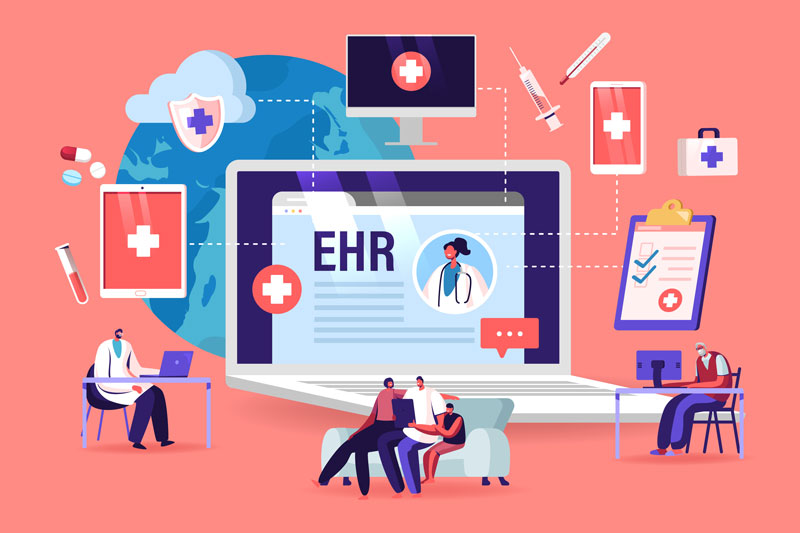After a tumultuous few years, the forecast is finally getting brighter for hospital finances in 2024. While the healthcare industry still bears deep scars from a crushing pandemic, lingering staffing shortages, and soaring expenses, data indicates that the storm clouds may finally be parting. Leading research firms and financial analysts predict this year will bring stabilization, if not modest gains, for hospital revenue and profitability.
While the path forward holds continued business challenges, several pivotal trends will impact healthcare finances in the upcoming year. Continue reading for insights into the emerging dynamics that will influence hospital finances and understand why CFOs should approach the future with cautious optimism.
EHRs: A financial double-edged sword
Electronic health records (EHR) have become indispensable for streamlining healthcare operations and improving patient care, yet they can also be a financial double-edged sword.
As hospital mergers continue and systems eye new technologies, EHR integrations and upgrades will continue to be a significant expense. Shockingly, EHR installs can cost upwards of $500 million, and mismanaged EHR system transitions have even pushed some hospitals toward bankruptcy.
Hospitals have reported that EHR upgrades can disrupt workflows and hinder data access, severely impacting productivity. Savvy hospitals looking to avoid these financial pitfalls are turning to enterprise-wide EHR data management systems. These systems ensure a seamless transition and mitigate the financial growing pains associated with EHR upgrades or mergers.
Automation accelerates RCM
In 2024, automation will be a game-changer for hospital revenue cycle management (RCM). A study by Bain & Company and KLAS Research reveals that 75% of hospital respondents expect to increase their software and technology spending in the coming year, with revenue cycle management topping their priority list.
The report underscores how automated RCM solutions can bolster revenue through improved collections and cost savings by streamlining labor-intensive processes. By embracing automation, hospitals can optimize revenue collection, reduce payer denials, stay ahead of emerging financial trends, and maximize cash flow.
Outsourcing goes mainstream
Staffing shortages continue to plague hospitals, compelling them to explore alternative solutions. McKinsey predicts that outsourcing will surge due to widening gaps in in-house capabilities and the increasing difficulty of sourcing essential talent.
A recent study by Black Book Research suggests that outsourcing will gain even more traction over the next five years, with 91% of hospitals planning to outsource at least some of their various functions. Hospitals will turn to external vendors for advanced capabilities in areas such as data analytics, human resources, IT, and finance. This trend allows hospitals to optimize their operations while ensuring cost-effectiveness and efficiency.
Stabilization on the horizon
After enduring years of financial turmoil catalyzed by the COVID-19 pandemic, the healthcare industry is slowly regaining its financial footing in 2024. Moody’s Investor Services has upgraded the 2024 healthcare outlook from “negative” to “stable,” providing a small glimmer of hope for hospital CFOs.
While labor and supply costs are expected to rise, operating margins are gradually improving. Incremental upticks in patient volume and higher reimbursement rates will contribute to this positive financial trajectory. Moody’s predicts that these trends will drive growth in operating cash flow margins, enabling hospitals to remain profitable.
Conclusion
In 2024, healthcare industry finances are poised for a resurgence. While business challenges persist, hospitals have the opportunity to thrive by investing in EHR data management systems, embracing automation for revenue cycle management, and leveraging outsourcing to address staffing shortages. The financial landscape may be uncertain, but with strategic planning and innovation, hospitals can navigate the road ahead and emerge stronger than ever.
Additional Reading
- Whitepaper: How Hospital CEOs Can Tackle Their Biggest Challenges Using Analytics
- Success story: How Southern Ohio Medical Center Saved $2 Million Annually with Analytics
- Data sheet: Revenue Cycle Advisor
- Why We’re Best in KLAS—Again! - February 7, 2024
- Building a Greener Healthcare System with Data Analytics - January 22, 2024
- Hospital Finance Predictions for 2024 - January 8, 2024





